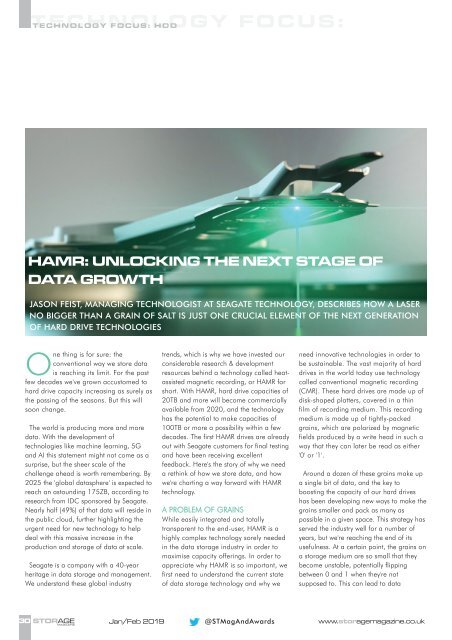ST1901
Create successful ePaper yourself
Turn your PDF publications into a flip-book with our unique Google optimized e-Paper software.
TECHNOLOGY FOCUS: HDD FOCUS:<br />
HAMR: UNLOCKING THE NEXT STAGE OF<br />
DATA GROWTH<br />
JASON FEIST, MANAGING TECHNOLOGIST AT SEAGATE TECHNOLOGY, DESCRIBES HOW A LASER<br />
NO BIGGER THAN A GRAIN OF SALT IS JUST ONE CRUCIAL ELEMENT OF THE NEXT GENERATION<br />
OF HARD DRIVE TECHNOLOGIES<br />
One thing is for sure: the<br />
conventional way we store data<br />
is reaching its limit. For the past<br />
few decades we've grown accustomed to<br />
hard drive capacity increasing as surely as<br />
the passing of the seasons. But this will<br />
soon change.<br />
The world is producing more and more<br />
data. With the development of<br />
technologies like machine learning, 5G<br />
and AI this statement might not come as a<br />
surprise, but the sheer scale of the<br />
challenge ahead is worth remembering. By<br />
2025 the 'global datasphere' is expected to<br />
reach an astounding 175ZB, according to<br />
research from IDC sponsored by Seagate.<br />
Nearly half (49%) of that data will reside in<br />
the public cloud, further highlighting the<br />
urgent need for new technology to help<br />
deal with this massive increase in the<br />
production and storage of data at scale.<br />
Seagate is a company with a 40-year<br />
heritage in data storage and management.<br />
We understand these global industry<br />
trends, which is why we have invested our<br />
considerable research & development<br />
resources behind a technology called heatassisted<br />
magnetic recording, or HAMR for<br />
short. With HAMR, hard drive capacities of<br />
20TB and more will become commercially<br />
available from 2020, and the technology<br />
has the potential to make capacities of<br />
100TB or more a possibility within a few<br />
decades. The first HAMR drives are already<br />
out with Seagate customers for final testing<br />
and have been receiving excellent<br />
feedback. Here's the story of why we need<br />
a rethink of how we store data, and how<br />
we're charting a way forward with HAMR<br />
technology.<br />
A PROBLEM OF GRAINS<br />
While easily integrated and totally<br />
transparent to the end-user, HAMR is a<br />
highly complex technology sorely needed<br />
in the data storage industry in order to<br />
maximise capacity offerings. In order to<br />
appreciate why HAMR is so important, we<br />
first need to understand the current state<br />
of data storage technology and why we<br />
need innovative technologies in order to<br />
be sustainable. The vast majority of hard<br />
drives in the world today use technology<br />
called conventional magnetic recording<br />
(CMR). These hard drives are made up of<br />
disk-shaped platters, covered in a thin<br />
film of recording medium. This recording<br />
medium is made up of tightly-packed<br />
grains, which are polarized by magnetic<br />
fields produced by a write head in such a<br />
way that they can later be read as either<br />
'0' or '1'.<br />
Around a dozen of these grains make up<br />
a single bit of data, and the key to<br />
boosting the capacity of our hard drives<br />
has been developing new ways to make the<br />
grains smaller and pack as many as<br />
possible in a given space. This strategy has<br />
served the industry well for a number of<br />
years, but we're reaching the end of its<br />
usefulness. At a certain point, the grains on<br />
a storage medium are so small that they<br />
become unstable, potentially flipping<br />
between 0 and 1 when they're not<br />
supposed to. This can lead to data<br />
30 STORAGE<br />
Jan/Feb 2019<br />
@STMagAndAwards<br />
www.storagemagazine.co.uk<br />
MAGAZINE

















